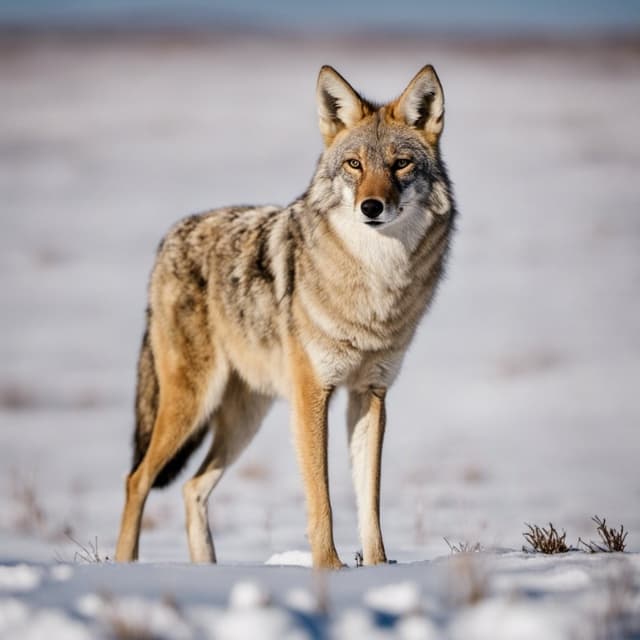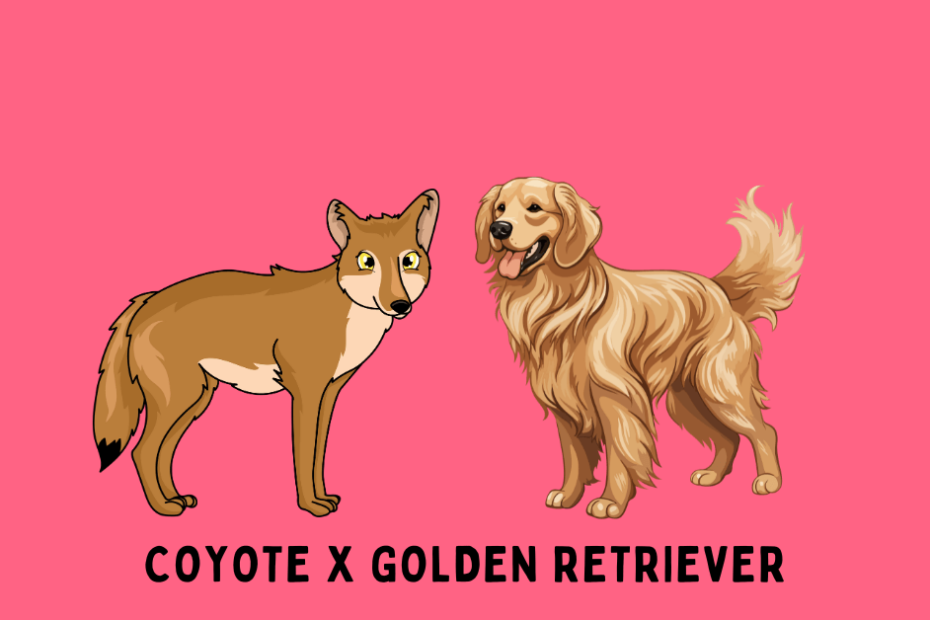Ever wondered what happens when the loyalty of a Golden Retriever meets the resourcefulness of a Coyote?
Meet the Coyote-Golden Retriever mix, a unique blend of domestic and wild that’s as fascinating as it sounds.
Curious? Read on to discover what makes this rare coyote-dog mix so intriguing!
What is a Golden Retriever-Coyote mix?
The Golden Retriever-Coyote mix results from crossbreeding a male Coyote and a female Golden Retriever. This combination is referred to as a Coydog.
This unique combination between two distinct species creates a fascinating and beautiful offspring that inherits traits from both parent breeds.

Though canid hybrids have been occurring for generations, the Golden Retriever-Coyote mix is a more recent development.
Throughout history, humans have crossed various dog breeds with wolves and other wild canines, often searching for specific traits or advantages in hunting and working.
The Golden Retriever-Coyote mix, or Golden Coydog, is another example of such efforts, blending the sociable nature of the Golden Retriever with the cunning and adaptability of the Coyote.
| Characteristic | Description |
| Breed Name | Coyote-Golden Retriever mix, Golden Coydog |
| Size | Medium to Large (50-85 lbs) |
| Lifespan | 10-12 years |
| Color | Varies (Golden, Grizzled, Brown, etc.) |
| Temperament | Friendly yet protective; unpredictable at times |
| Intelligence | High |
| Trainability | Moderate to High; early socialization essential |
| Exercise Needs | High; needs both physical and mental stimulation |
| Socialization | Vital from an early age |
| Diet | Omnivorous; quality dog food and occasional fruits |
| Common Health Issues | Varies; subject to genetic conditions of both breeds |
| Living Conditions | Needs spacious living conditions; not suitable for apartments |
| Legal Considerations | Check local laws for hybrid animal ownership |
History of the Parent Breeds
To better understand this mix, it’s worth taking some time to learn about the histories of both parents.
This will give us a better idea of what traits a Coyote-Golden Retriever mix inherits.
Golden Retriever
The Golden Retriever originated in the British Isles during the late 19th century.
The breed was developed to create an efficient, obedient, and friendly gundog that excelled in retrieving waterfowl and upland game.

The vision of Sir Dudley Marjoribanks, also known as Lord Tweedmouth, gave rise to this now-popular breed.
Between 1868 and 1890, Lord Tweedmouth engaged in a systematic breeding program on his estate in Scotland.
Starting with a yellow retriever named “Nous” and a now-extinct Tweed Water Spaniel named “Belle,” he aimed to develop a dog with keen intelligence, exceptional swimming ability, and a gentle temperament.
Later generations saw the infusion of additional breeds, including the Irish Setter and Bloodhound, to refine specific traits.
Golden Retrievers were first exhibited in 1908, and their popularity soared in subsequent decades.
The Kennel Club of England officially recognized the breed in 1911 under the name “Retriever (Golden and Yellow),” while the American Kennel Club granted recognition in 1925.
The breed’s charm, intelligence, and versatility soon made it an ideal candidate for various roles beyond hunting, such as search and rescue, assistance for individuals with disabilities, and even roles in television and film.
Today, Goldens are ranked in the top 3 most popular dog breeds in the United States.
Coyote
Coyotes are North American canids and part of the dog family, scientifically known as Canidae. They’re smaller and lighter than wolves.
Their scientific name is Canis latrans. “Coyote” comes from an Aztec word, “coyotl.”

You’ll find them everywhere, from Alaska to Central America, but they’re especially common in the U.S. Great Plains. Once, they mostly lived west of the Appalachian Mountains, but now they’re all over the U.S. and Canada.
Coyotes mostly come out at night and are known for their eerie howls and yaps. They’re great at hunting and can run as fast as 40 mph.
Their sharp senses help them find food, especially in places with many plants.
In colder areas, they like to eat snowshoe hares and white-tailed deer. To catch their prey, they usually bite its back legs and end with a strong bite to the throat. They’ll eat berries, fruits, and even dead animals if regular food is hard to find.
People have talked about Coyotes for a long time, especially in Native American stories, where they’re often clever and tricky.
As more people have moved into Coyote areas, there’s been conflict and interest in studying these animals to understand them better.
Physical Traits and Appearance
The Golden Coydog’s overall appearance is a captivating mix of wild and domestic beauty, showcasing the characteristics of its unique heritage.
Size
This hybrid will typically have a size and weight that fall somewhere between that of its Golden Retriever and Coyote parents. As such, the Golden Coydog may have an average weight ranging from 50 to 85 pounds and a height of 20 to 24 inches at the shoulder.
Their moderately bulky frame allows for their agility and quickness.
Coat
Their coat colors can include a fascinating blend of shades found in both the Golden Retriever—known for its lustrous golden coat—and the diverse colors of the Coyote, which can include grey, brown, and even reddish hues.
The texture of their fur may be anything from silky and wavy to thick and dense.
Tail
The tail of the Golden Coydog will likely be bushy, reminiscent of its Coyote ancestors, which use their fluffy tails for balance and communication.
Face
Their facial features often demonstrate a combination of the purebred Golden Retriever’s affectionate, warm expression and the wild, intelligent gaze of the Coyote.
They may have the piercing eyes of a Coyote and a distinct mask of color.
The ears can be perky and triangular like a Coyote or slightly folded like a Golden Retriever’s, depending on which genes are more dominant.
Personality and Temperament
This mix brings together the best qualities of both parent breeds, creating a companion with a delightful combination of traits, such as intelligence, loyalty, and energetic nature.
Living with a Golden Retriever-Coyote mix
Coydog Retrievers are known to be intelligent and energetic, making them a delightful addition to an active family.
They are often loyal and form strong bonds with their human family members, always eager to please and show their affection.
These dogs thrive on interaction, play, and training, keeping their minds engaged and even making them shy away from aggressive tendencies.
It’s difficult to predict their exact temperament. Some dogs may show more outgoing and bold personality traits from the Golden Retriever side, while others could take on more timid tendencies more commonly associated with Coyotes.
Early socialization and proper training are crucial for helping this mix develop into a well-balanced and confident companion.
Are they good with children?
Golden Retriever-Coyote mixes are generally expected to be playful, energetic, and affectionate towards people. Especially when properly socialized.
They often display enthusiasm and excitement, making them great companions for children who enjoy active play.
Keep in mind that they also possess some traits from their Coyote lineage. This may result in occasional wariness or caution, particularly around unfamiliar children.
Make sure to introduce your Golden Retriever-Coyote mix to children slowly and carefully, allowing time and space to develop trust and familiarity.
Are they good with other pets?
With their Golden Retriever genes, Golden Coydogs are friendly and outgoing. They should have no problem getting along well with other dogs and even cats.
They are usually good playmates, eager to engage in energetic romps and games with their fellow furry friends.
However, some may have a stronger prey instinct from their Coyote lineage.
This may cause them to behave more aggressively or boldly around smaller animals, such as rodents or birds.
Early socialization and training can help mitigate these instincts and teach them to interact calmly and safely with other pets in the household.
Diet and Exercise
Golden Retriever-Coyote mix dogs are highly energetic and require a well-balanced diet and regular exercise to stay healthy and happy. Let’s explore their dietary requirements and exercise routine.
Dietary Requirements
Golden Retriever-Coyote mixes need a nutrient-rich diet to support their active lifestyle. Their diet should consist of:
- High-quality dog food: Choose dog food formulas with a good balance of protein, fats, and carbohydrates to provide the necessary energy.
- Protein sources: Opt for lean meats like chicken, turkey, and fish, which are more accessible for your pet to digest and utilize for muscle growth and maintenance.
- Healthy fats: Fats are essential for brain development, healthy skin, and coat. Fish oil, flaxseed oil, or coconut oil are excellent sources of essential fatty acids.
- Bones: Make sure to include bones in their diet to maintain healthy teeth and gums. Avoid cooked bones, as they can splinter and cause injury.
Remember always to provide fresh water for your Golden Retriever-Coyote mix.
Exercise Routine
Golden Retriever-Coyote mixes are energetic and require regular exercise to expend energy, maintain a healthy weight, and avoid boredom, which can lead to destructive behavior.
Here are some exercise ideas for your pet:
- Daily walks: Aim for at least two 30-minute daily walks for your Golden Retriever-Coyote mix. This will help burn energy and keep their joints healthy.
- Fetch and chase: Throwing a ball or a frisbee in the park can be a fun and exciting way for your pet to stretch their legs and build endurance.
- Hiking adventures: Since Golden Retriever-Coyote mixes love the outdoors, take them on hiking trips on weekends or whenever you have time. This will help keep them physically and mentally stimulated.
- Engaging in agility courses: Setting up an agility course in your backyard or participating in local agility classes can provide an excellent outlet for your pet’s energy and athleticism.
- Swimming: Golden Retriever-Coyote mixes often enjoy swimming, and it’s an excellent low-impact exercise, especially for dogs with joint issues.
A well-balanced diet and consistent exercise will ensure they live a healthy and happy life for a Golden Coydog.
Health and Lifespan
Common Health Issues
Golden Retriever-Coyote mixes can be susceptible to some health issues that may affect their parent breeds.
Since they inherit genes from both the Golden Retriever and the Coyote, these pups are at risk for health conditions such as:
- Hip dysplasia: A common issue among larger breeds like Golden Retrievers, hip dysplasia can cause pain and limited mobility as the dog ages.
- Allergies: Some Golden Coyotes might inherit skin and food allergies from their Golden Retriever parent, causing itching, irritation, or dietary complications.
- Dental Issues: Like their Coyote relatives, Golden Coyotes can face dental problems, including gum infections and tooth decay.
How long do they live?
The average lifespan of a Coyote-Golden Retriever is between 10-12 years.
Living Conditions and Care
As an owner of the rare and unique Golden Retriever-Coyote mix, ensuring proper living conditions and specialized care will make a difference for this fantastic hybrid. This section will explore the housing requirements and how to manage aggression in these beautiful animals!
Housing Requirements
A secure yard is crucial for both exercise and safety for your Golden Retriever-Coyote mix.
A fenced yard should be at least 6 feet tall to prevent any chance of escape and ensure they have plenty of space to roam, play, and explore.
Providing a mix of grass and shaded areas will allow for optimal comfort and enjoyment.
Remember to pet-proof your living space within the home, removing any potential hazards or items that could be chewed.
Since these animals are known to be curious, regular home inspections are essential to keep up with any new interests that may tickle your mix’s fancy.
Due to their instincts, it’s not uncommon for your mix to dig, so be prepared to find holes in your yard.
Prevent major damage by designating a safe digging zone filled with soft earth or sand, allowing them to express their natural behavior without compromising your landscaping!
Behavioral Traits
We will not pretend that a dog mixed with a Coyote will behave like any other pooch. Some unique traits are worth being aware of.
Barking and Howling
When it comes to barking and howling, these hybrids exhibit a unique blend of the lively Golden Retriever and the vocal Coyote.
They may produce various sounds, ranging from typical barks to distinct howls.
Such vocalizations can vary in intensity and frequency, depending on individual personalities and environmental factors.
Dealing with Aggression
While the Golden Retriever-Coyote mix may inherit the friendly nature of a retriever, they may also showcase aggression inherited from their Coyote lineage.
Addressing these aggressive tendencies early on will make a difference in ensuring a safe and harmonious relationship.
- Socialization: From a young age, expose your mix to various environments, people, and other animals to help them become more comfortable and better behaved in different situations.
- Training: Consistency in obedience school or positive reinforcement training will establish proper behavior and boundaries.
- Exercise: Regular exercise is vital for these energetic hybrids, as boredom can lead to destructive behaviors or aggression. Lengthy walks, playtime in the secure yard, and mentally stimulating activities will keep them content.
- Attention: Provide affection and attention to build trust. A strong bond will minimize the potential for aggressive behavior.
Prey drive
As part Coyote, your pet may have a stronger prey drive than a typical domestic dog. It’s essential to keep this in mind when introducing them to smaller animals or when taking them on walks in the great outdoors.
Potential Challenges
While Golden Retriever-Coyote mixes can make fantastic pets, it’s crucial to be aware of their potential challenges.
Since they are part wild, these mixes may display more assertive behaviors and require confident, experienced handling.
Investing time and effort into obedience training and socialization from a young age is vital to set them up for success in a family environment.
Legal issues
I’m not a legal expert, but owning a hybrid animal like a Coyote-Golden Retriever mix could fall under various legal jurisdictions, depending on where you live.
Many states and municipalities have specific laws governing the ownership of wild or hybrid animals. These laws may require special permits or even prohibit ownership altogether.
Some places may classify a coyote-dog hybrid as an “exotic” or “dangerous” animal, subject to specific regulations such as mandatory enclosures, microchipping, or liability insurance.
Failure to comply with these laws can result in fines, confiscation of the animal, and, in some cases, criminal charges.
If you are considering owning or breeding such a mix, it is crucial to consult with local and state wildlife agencies to understand what laws and regulations may apply. In addition, you should consult a legal advisor to ensure you fully comply with all relevant statutes.
Always seek professional legal advice for your specific circumstances.
Don’t miss this mix!
Did you like the Golden Retriever-Coyote mix? You won’t believe the Pit Bull-Coyote mix!


